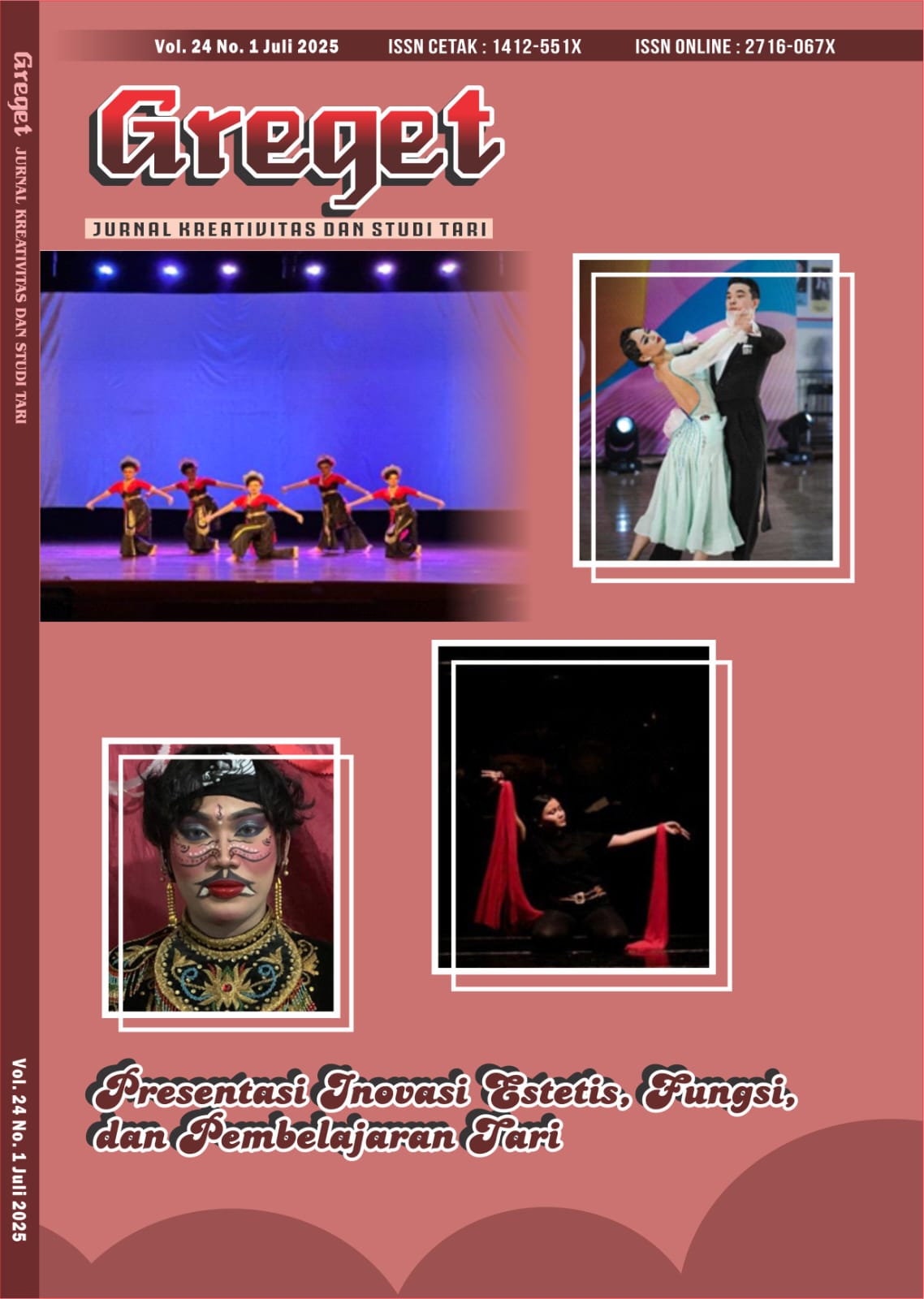BENTUK DAN FUNGSI PERTUNJUKAN TARI KUDA LUMPING “MASAL DEWASA” : STUDI ETNOKOREOLOGI DI PAGUYUBAN TURONGGO BUDHOYO MASIRAN
Main Article Content
Abstract
This study investigates the form and function of the “Masal Dewasa” Kuda Lumping dance as performed by the Turonggo Budhoyo community in Masiran Hamlet, Kaligading Village, Boja District, Kendal Regency. It addresses two research questions: (1) What constitutes the form of the “Masal Dewasa” Kuda Lumping dance? and (2) What functions does this performance serve? Framed by M. Jazuli’s theoretical perspective, the study employs a qualitative methodology with a descriptive ethnochoreological approach. Data were gathered through participant observation, in‑depth interviews, and performance documentation. Findings indicate that the “Masal Dewasa” Kuda Lumping dance is a collective ensemble performance comprising ten interrelated elements—among them theme, movement vocabulary, performers, musical accompaniment, props, costumes, make‑up, and floor patterns. Functionally, the dance fulfills ceremonial, entertainment, spectacular, social, and cultural‑preservation roles. In this way, it operates not only as an artistic expression but also as a living symbol of the local community’s cultural identity.
Downloads
Article Details

This work is licensed under a Creative Commons Attribution-ShareAlike 4.0 International License.
Copyright
Authors who publish with GREGET agrees to the following terms:
- Authors retain copyright and grant the journal right of first publication with the work simultaneously licensed under a Creative Commons Attribution-ShareAlike 4.0 (CC BY-SA 4.0) that allows others to share the work with an acknowledgment of the work's authorship and initial publication in this journal.
- Authors are able to enter into separate, additional contractual arrangements for the non-exclusive distribution of the journal's published version of the work (e.g., post it to an institutional repository or publish it in a book), with an acknowledgment of its initial publication in this journal.
- Authors are permitted and encouraged to post their work online (e.g., in institutional repositories or on their website) prior to and during the submission process, as it can lead to productive exchanges, as well as earlier and greater citation of published work.
References
Agustin, N. D., & Lutfiati, D. (2020). Kajian Bentuk dan Makna Tata Rias Tari Bedhaya Bedhah Madiun di Pura Mangkunegaran Surakarta. E-Journal , IX(1), 84–91.
Alfansyur, A., & Mariyani. (2020). Seni Mengelola Data : Penerapan Triangulasi Teknik , Sumber Dan Waktu pada Penelitian Pendidikan Sosial. Historis, 5(2), 146–150.
Badaruddin, S. (2022). SILAMPARI Sebuah Identitas dan Jati diri. Pustaka Aksara.
Hardiani, C., & Firdhani, A. M. (2022). Kesenian Kuda Lumping: Tinjauan Studi Multiperspektif. Indonesian Journal Of Performing Arts Education, 2(1), 15–19.
Hendra, D. F. (2023). Kajian Dasar Bentuk Gerak Tari Dan Musik Iringan Tari Zapin Penyengat. Jurnal Pendidikan Dan Kajian Seni, 8(2), 114–127.
Hera, T. (2020). Fungsi Tari Tanggai Di Palembang. GETER : Jurnal Seni Drama, Tari Dan Musik, 3(1), 64–77. https://doi.org/10.26740/geter.v3n1.p64-77
Hidayat, V. A. (2020). Gerak Dan Rasa Dalam Tari Merak Jawa Barat. DESKOVI : Art and Design Journal, 3(2), 104. https://doi.org/10.51804/deskovi.v3i2.804
Jazuli, M. (2016). Peta Dunia Seni Tari (1st ed.). CV. Farisma Indonesia.
Jazulli, M. (2016). Sosiologi Seni: Pengantar & Model Seni (- (ed.); 2nd ed., Issue June 2016). Graha Ilmu.
Khoiroh, K., & Kusumastuti, E. (2020). Eksistensi Kesenian Barongan Kusumojoyo Desa Gebang Kecamatan Bonang Kabupaten Demak. Jurnal Seni Tari, 9(1), 1.
Mastra, I. W. (2022). Elemen-Elemen Estetis Komposisi Tari. Widyadharma: Prosiding Pendidikan Seni Drama, Tari Dan Musik, 1(1), 144–152. https://ojs.mahadewa.ac.id/index.php/widyadharma/article/view/2223
Narawati, T. (2020). Etnokoreologi: teori dan praktik dalam pendidikan. In UPI. UPI Press.
Nirwana, J. (2023). Kesenian Kuda Lumping Kajian Filosofis Adat Jawa Desa Retak Ilir Kecamatan Ipuh Kabupaten Mukomuko. Repository Perpustakaan UIN FAS Bengkulu. http://repository.uinfasbengkulu.ac.id/72/
Purwaningsari, D., & Arhon Dhony, N. N. (2022). Aspek Penari Dalam Koreografi Kelompok Tari Kipas Chandani Di Sanggar Sastra Mataya. GETER : Jurnal Seni Drama, Tari Dan Musik, 5(1), 18–35. https://doi.org/10.26740/geter.v5n1.p18-35
Rohidi, T. R., & Mulyarto. (2009). Analisis data kualitatif : buku sumber tentang metode-metode baru / Matthew B. Miles, A. Michael Huberman.; penerjemah Cecep Rohendi Rohidi, Mulyarto. UI Press.
Sebastian, D. P., & Widodo, E. (2023). Analisis Strategi Public Relations Teater Koma dalam Menjaga Minat Penonton Selama Pandemi Covid-19. Jurnal InterAct, 12(1), 22–35. https://doi.org/10.25170/interact.v12i1.4290
Supanto, R., & Paranti, L. (2024). Bentuk Dan Fungsi Pertunjukan Tari Sluku-Sluku Bathok Paguyuban Turonggo Seto Kabupaten Purworejo. Gesture: Jurnal Seni Tari, 13(1), 114. https://doi.org/10.24114/gjst.v13i1.56670
Susanti, Y. A., & Widyastuti, M. (2023). Fungsi Reog Singo Wogro Dalam Suronan Di Desa Maitan Kabupaten Pati. Jurnal Sitakara, 8(2), 206–220. https://doi.org/10.31851/sitakara.v8i2.12805
Wahyudi, A. V., Lutfatulatifah, L., Jayanti, Y. D., & Mulyana, A. (2022). Pelatihan Tari Kreatif Menggunakan Properti Tari Sebagai Media Eksplorasi Guru Paud Di Kecamatan Plumbon Kabupaten Cirebon. Abdimas Galuh, 4(2), 818. https://doi.org/10.25157/ag.v4i2.7661
Wahyuni, D. T., Rochayati, R., & Siswanto, S. (2023). Deskripsi Tari Jaran Buto Dalam Perspektif Tata Rias dan Busana di Kabupaten Banyuasin Sumatra Selatan. ANTHOR: Education and Learning Journal, 2(4), 440–446. https://doi.org/10.31004/anthor.v2i4.169
